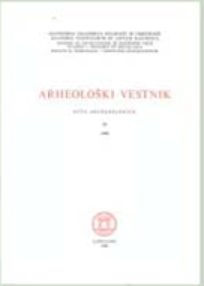Some New A ntique Monuments
Abstract
In 1947 while the edifice for the Planning' Commission in the court-yard of the printing-office »Merkur« in G regorčičeva ulica was being built, broken stone monuments Nos. 1 , 3 and 4 w ere excavated. The first two had been used as building m aterial in the groundw ork of the antique tow er at the outer side of the w estern p art of Emona walls. The inscription No. 1 in grayish lim e 1 stone, broken into six pieces and fragm entary, m ention^ a soldier of 2 nd praetorian cohort Pudens, who died in 14 A. D., at the tim e w hen DruS'us (Tac. Ann. I. 24,30) was ordered by em peror Tiberius to pacify the rebellious Pannonian legions in the (Surroundings of N auportus. M onument No. 3 of w hitish lim estone is fragm entary, too, and broken into two pieces; it tells us it was erected by the non-commissioned officer Marcus Sentius A lexander in the m em ory of hiš com rade M. A urelius C rispinianus, a soldier of XIIIth legion Gemina. It is even possible that the above-m entioned Sentius was a relation of a civilian of the same nam e from Apulium in D acia (CIL III. No. 7748) w here that legion was garrisoned. Thus the m onum ent originated in the reign of em peror G alienus (253—268 A. D.) when the Roman arm y abandoned D acia for ever; yet some partis thereof w ere proved to have been at P tu j (Abramić, Poetovio, str. 183, Hoffiiller-Säria, A ntike Inschriften aus Jugoslaw ien pp. 147 sq.). The upper p art of the m arble tombstone, decorated by dolphins, belongs as to its shape and beautiful elaboration to 1 st century A. D. M onument No. 2 of w hite limestone was found in Aškerčeva ulica near the Roman cloaca. It is significant that in the acroterion the plastic, badly ela[1]borated rosette is divided by a G reek hewn-in cross into four parts. It had been erected by C. Bononius Achilleus for Ms m other-in-law I Iberia. His m other-in-law had been probably born in the reign of em peror 1 iberius (J4—3 7 A. D.j, and it is possible that the monument was erected about the y ear 1 0 0 A. D. Bononius A chilleus was probably of G reek origin, and it is possible th a t he was C hristian. The hew n-in cross in the acroterion which was used here as an ornam ent seem s to confirm th a t view. Two m ore m onu[1]m ents in L ju b ljan a (CIL 111. 3860 and 3895, H offiller-Saria, AIJ No. 185 and No. 216) have a hew n-in hidden cross in th eir rosette; one m onum ent from T riest has in its rosette a cross very sim ilar to ours. This m onum ent (CIL Y. No. 475. D egrassi, Inscriptiones Italiae, Yol. X. Regio X. Fase. III. Histrda Sep[1]tentrionalis No. 50) originates from the period after C onstatine the G reat already, and it is certainly C hristian. Thus it is su re th a t in our case the C hristian G reek A chilleus has come to Emona, and th a t we have here a very ea rly ancient C hristian m onum ent, probably from about the year 1 0 0 A. D
Downloads
Downloads
Published
How to Cite
Issue
Section
License

This work is licensed under a Creative Commons Attribution-NonCommercial-ShareAlike 4.0 International License.
Authors guarantee that the work is their own original creation and does not infringe any statutory or common-law copyright or any proprietary right of any third party. In case of claims by third parties, authors commit their self to defend the interests of the publisher, and shall cover any potential costs.
More in: Submission chapter





